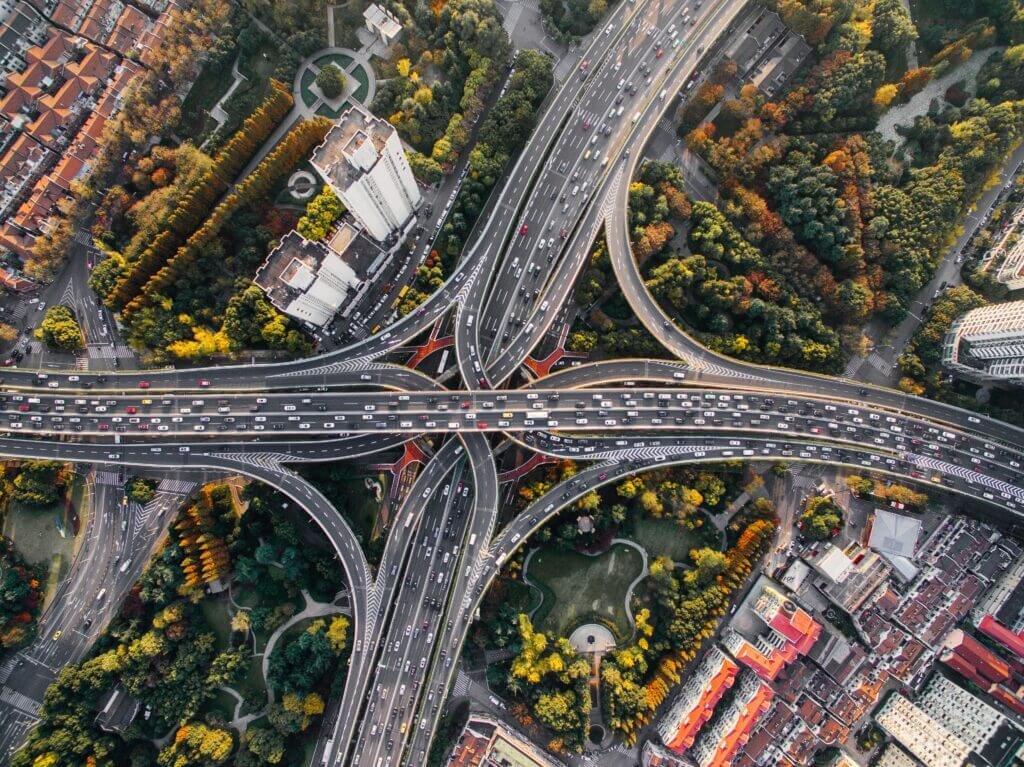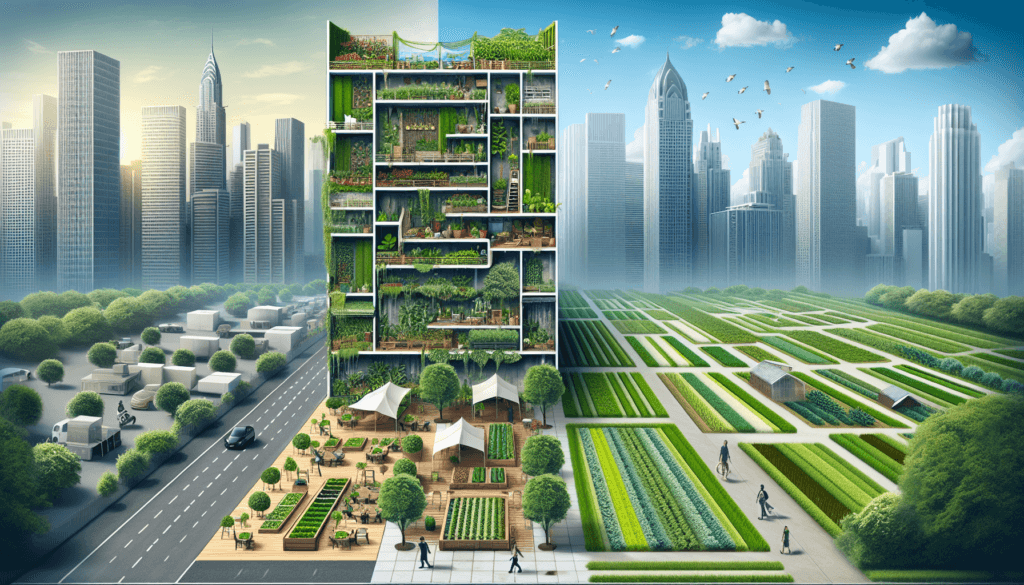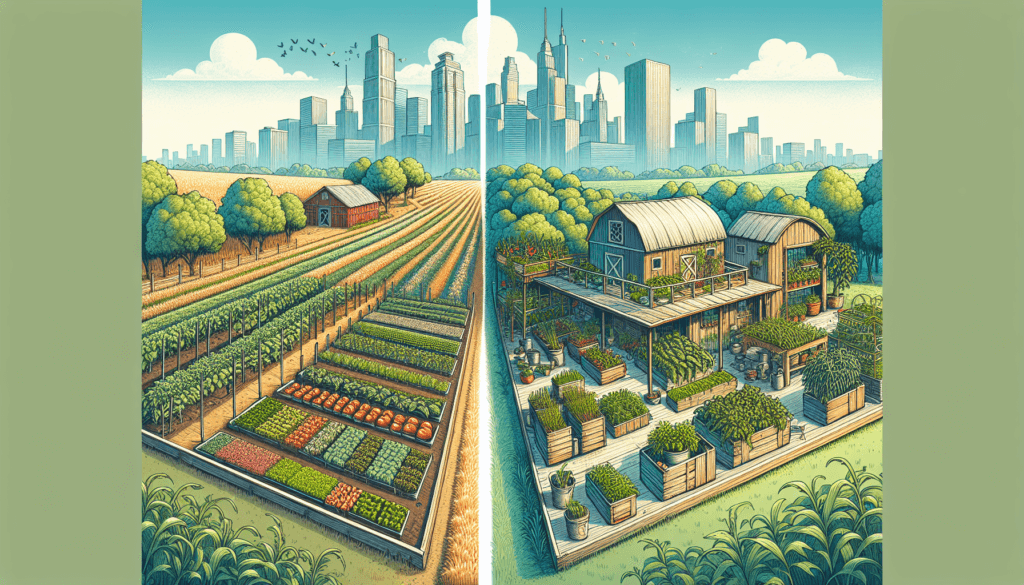Imagine having your own thriving green oasis right in the heart of a bustling city. Urban gardening offers exactly that – a unique solution for those craving the beauty and benefits of a garden, even in the midst of a concrete jungle. But what sets it apart from traditional gardening? In this article, we will explore the distinct characteristics of urban gardening, from its innovative use of space to its emphasis on sustainable practices. Whether you’re a city dweller or a gardening enthusiast, prepare to be inspired by the world of urban gardening and discover how it can transform your surroundings, your health, and your connection to nature.

Overview
Urban gardening refers to the practice of growing plants in an urban setting, where space is limited and often at a premium. It is a way for city dwellers to connect with nature and enjoy the benefits of gardening despite living in a concrete jungle. Normal gardening, on the other hand, refers to gardening practices in more traditional settings such as suburban or rural areas, where space is not as constrained.
Space Considerations
One of the main differences between urban gardening and normal gardening lies in the available space. Urban gardening is characterized by limited space, often restricted to balconies, rooftops, or small plots of land. As a result, creative solutions such as vertical gardening and container gardening are often employed to maximize space utilization. In contrast, normal gardening has the luxury of larger spaces, allowing for more expansive garden layouts and the opportunity to cultivate a wider variety of plants.
Location
Urban gardening is primarily practiced in densely populated areas, where access to green spaces and traditional gardens may be limited. It serves as a means for city dwellers to bring nature into their surroundings and create pockets of green amidst concrete jungles. Normal gardening, on the other hand, is more commonly associated with suburban or rural areas, where larger plots of land are available for gardening purposes.
Types of Plants
The types of plants that are suitable for urban gardening differ from those commonly found in normal gardening. In urban settings, plants that thrive in containers and have compact growth habits are favored. This includes herbs, salad greens, and small vegetables such as cherry tomatoes and peppers. Normal gardening, with its larger space options, allows for a wider variety of plants to be grown, including larger vegetables, fruit trees, and perennial flowers.

Container Gardening
Container gardening takes center stage in urban gardening due to the limited space available. This practice involves growing plants in containers, such as pots, hanging baskets, or vertical planters. Containers are not only space-saving but also portable, allowing urban gardeners to move their plants as needed for optimal sunlight exposure or temperature control. In contrast, normal gardening relies less on containers as there is ample space to directly plant in the ground.
Vertical Gardening
Another technique commonly used in urban gardening is vertical gardening. Since horizontal space is limited, vertical gardening allows for the utilization of vertical surfaces such as walls or trellises to grow plants. This can be accomplished using techniques such as living walls, trellises, or stacked containers. In normal gardening, vertical gardening techniques are not as prevalent since there is generally enough horizontal space to spread out plants.

Soil Considerations
In urban gardening, access to quality soil may be limited due to the lack of open ground and the presence of contaminations in urban areas. Therefore, urban gardeners often rely on container gardening techniques with specialized potting mixes or utilize raised beds with imported soil. Normal gardening, on the other hand, benefits from the availability of ample soil options and generally does not face the same challenges as urban gardening in terms of soil quality and contamination.
Watering and Irrigation
Urban gardening often requires specific watering methods due to the limited soil volume and exposure of plants to sunlight and wind. Techniques such as drip irrigation or self-watering containers are commonly used to ensure plants receive adequate moisture. In normal gardening, more conventional watering methods are employed, including hand watering or using sprinkler systems due to the larger and more spread-out nature of the garden.

Pest and Disease Control
Pest and disease control in urban gardening can pose unique challenges. The close proximity of gardens in urban areas can lead to higher pest populations and increased disease spread. Urban gardeners often employ integrated pest management techniques, such as companion planting or organic pest control methods, to tackle these challenges. In normal gardening, although pest and disease issues exist, they may not be as prevalent as in urban gardening, and standard pest control measures such as insecticides or fungicides are more commonly used.
Community and Social Aspect
One of the distinguishing features of urban gardening is its collaborative and community-focused nature. Urban gardeners often come together to share resources, knowledge, and even garden spaces. Community gardens play a significant role in urban gardening, providing individuals with a sense of belonging and fostering social connections. In normal gardening, the focus is more individualistic, with gardeners typically tending to their own private plots of land without as much emphasis on communal activities.
In conclusion, urban gardening and normal gardening differ in various aspects, including space considerations, plant choices, gardening techniques, soil availability, watering methods, pest and disease control, and the community and social aspect. Urban gardening allows individuals in densely populated areas to embrace their green thumbs despite limited space by utilizing creative techniques such as container gardening and vertical gardening. On the other hand, normal gardening benefits from larger spaces and a wider array of plant options, providing gardeners in suburban or rural areas with the opportunity for more expansive and diverse gardens. Regardless of the setting, both forms of gardening offer their own unique joys and opportunities to connect with nature.


